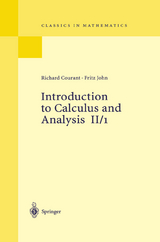Introduction to Calculus and Analysis II/1
Springer Berlin (Verlag)
978-3-540-66569-4 (ISBN)
Newsletter on Computational and Applied Mathematics, 1991
"...one of the best textbooks introducing several generations of mathematicians to higher mathematics. ... This excellent book is highly recommended both to instructors and students."
Acta Scientiarum Mathematicarum, 1991
Richard Courant was born in 1888 in a small town of what is now Poland, and died in New Rochelle, N.Y. in 1972. He received his doctorate from the legendary David Hilbert in Göttingen, where later he founded and directed its famed mathematics Institute, a Mecca for mathematicians in the twenties. In 1933 the Nazi government dismissed Courant for being Jewish, and he emigrated to the United States. He found, in New York, what he called "a reservoir of talent" to be tapped. He built, at New York University, a new mathematical Sciences Institute that shares the philosophy of its illustrious predecessor and rivals it in worldwide influence. For Courant mathematics was an adventure, with applications forming a vital part.
1 Functions of Several Variables and Their Derivatives.- 1.1 Points and Points Sets in the Plane and in Space.- 1.2 Functions of Several Independent Variables.- 1.3 Continuity.- 1.4 The Partial Derivatives of a Function.- 1.5 The Differential of a Function and Its Geometrical Meaning.- 1.6 Functions of Functions (Compound Functions) and the Introduction of New In-dependent Variables.- 1.7 The Mean Value Theorem and Taylor's Theorem for Functions of Several Variables.- 1.8 Integrals of a Function Depending on a Parameter.- 1.9 Differentials and Line Integrals.- 1.10 The Fundamental Theorem on Integrability of Linear Differential Forms.- Appendix A.1. The Principle of the Point of Accumulation in Several Dimensions and Its Applications.- A.2. Basic Properties of Continuous Functions.- A.3. Basic Notions of the Theory of Point Sets.- A.4. Homogeneous functions..- 2 Vectors, Matrices, Linear Transformations.- 2.1 Operations with Vectors.- 2.2 Matrices and Linear Transformations.- 2.3 Determinants.- 2.4 Geometrical Interpretation of Determinants.- 2.5 Vector Notions in Analysis.- 3 Developments and Applications of the Differential Calculus.- 3.1 Implicit Functions.- 3.2 Curves and Surfaces in Implicit Form.- 3.3 Systems of Functions, Transformations, and Mappings.- 3.4 Applications.- 3.5 Families of Curves, Families of Surfaces, and Their Envelopes.- 3.6 Alternating Differential Forms.- 3.7 Maxima and Minima.- Appendix A.1 Sufficient Conditions for Extreme Values.- A.2 Numbers of Critical Points Related to Indices of a Vector Field.- A.3 Singular Points of Plane Curves 360 A.4 Singular Points of Surfaces.- A.5 Connection Between Euler's and Lagrange's Representation of the motion of a Fluid.- A.6 Tangential Representation of a Closed Curve and the Isoperi-metricInequality.- 4 Multiple Integrals.- 4.1 Areas in the Plane.- 4.2 Double Integrals.- 4.3 Integrals over Regions in three and more Dimensions.- 4.4 Space Differentiation. Mass and Density.- 4.5 Reduction of the Multiple Integral to Repeated Single Integrals.- 4.6 Transformation of Multiple Integrals.- 4.7 Improper Multiple Integrals.- 4.8 Geometrical Applications.- 4.9 Physical Applications.- 4.10 Multiple Integrals in Curvilinear Coordinates.- 4.11 Volumes and Surface Areas in Any Number of Dimensions.- 4.12 Improper Single Integrals as Functions of a Parameter.- 4.13 The Fourier Integral.- 4.14 The Eulerian Integrals (Gamma Function).- Appendix: Detailed Analysis of the Process Of Integration A.1 Area.- A.2 Integrals of Functions of Several Variables.- A.3 Transformation of Areas and Integrals.- A.4 Note on the Definition of the Area of a Curved Surface.- 5 Relations Between Surface and Volume Integrals.- 5.1 Connection Between Line Integrals and Double Integrals in the Plane (The Integral Theorems of Gauss, Stokes, and Green).- 5.2 Vector Form of the Divergence Theorem. Stokes's Theorem.- 5.3 Formula for Integration by Parts in Two Dimensions. Green's Theorem.- 5.4 The Divergence Theorem Applied to the Transformation of Double Integrals.- 5.5 Area Differentiation. Transformation of Au to Polar Coordinates.- 5.6 Interpretation of the Formulae of Gauss and Stokes by Two-Dimensional Flows.- 5.7 Orientation of Surfaces.- 5.8 Integrals of Differential Forms and of Scalars over Surfaces.- 5.9 Gauss's and Green's Theorems in Space.- 5.10 Stokes's Theorem in Space.- 5.11 Integral Identities in Higher Dimensions.- Appendix: General Theory Of Surfaces And Of Surface Integals A.I Surfaces and Surface Integrals in Three dimensions.- A.2 The Divergence Theorem.- A.3Stokes's Theorem.- A.4 Surfaces and Surface Integrals in Euclidean Spaces of Higher Dimensions.- A.5 Integrals over Simple Surfaces, Gauss's Divergence Theorem, and the General Stokes Formula in Higher Dimensions.- 6 Differential Equations.- 6.1 The Differential Equations for the Motion of a Particle in Three Dimensions.- 6.2 The General Linear Differential Equation of the First Order.- 6.3 Linear Differential Equations of Higher Order.- 6.4 General Differential Equations of the First Order.- 6.5 Systems of Differential Equations and Differential Equations of Higher Order.- 6.6 Integration by the Method of Undermined Coefficients.- 6.7 The Potential of Attracting Charges and Laplace's Equation.- 6.8 Further Examples of Partial Differential Equations from Mathematical Physics.- 7 Calculus of Variations.- 7.1 Functions and Their Extrema.- 7.2 Necessary conditions for Extreme Values of a Functional.- 7.3 Generalizations.- 7.4 Problems Involving Subsidiary Conditions. Lagrange Multipliers.- 8 Functions of a Complex Variable.- 8.1 Complex Functions Represented by Power Series.- 8.2 Foundations of the General Theory of Functions of a Complex Variable.- 8.3 The Integration of Analytic Functions.- 8.4 Cauchy's Formula and Its Applications.- 8.5 Applications to Complex Integration (Contour Integration).- 8.6 Many-Valued Functions and Analytic Extension.- List of Biographical Dates.
From the reviews: "These books (Introduction to Calculus and Analysis Vol. I/II) are very well written. The mathematics are rigorous but the many examples that are given and the applications that are treated make the books extremely readable and the arguments easy to understand. These books are ideally suited for an undergraduate calculus course. Each chapter is followed by a number of interesting exercises. More difficult parts are marked with an asterisk. There are many illuminating figures...Of interest to students, mathematicians, scientists and engineers. Even more than that." Newsletter on Computational and Applied Mathematics, 1991 "...one of the best textbooks introducing several generations of mathematicians to higher mathematics. ... This excellent book is highly recommended both to instructors and students." Acta Scientiarum Mathematicarum, 1991
From the reviews: "These books (Introduction to Calculus and Analysis Vol. I/II) are very well written. The mathematics are rigorous but the many examples that are given and the applications that are treated make the books extremely readable and the arguments easy to understand. These books are ideally suited for an undergraduate calculus course. Each chapter is followed by a number of interesting exercises. More difficult parts are marked with an asterisk. There are many illuminating figures...Of interest to students, mathematicians, scientists and engineers. Even more than that." Newsletter on Computational and Applied Mathematics, 1991 "...one of the best textbooks introducing several generations of mathematicians to higher mathematics. ... This excellent book is highly recommended both to instructors and students." Acta Scientiarum Mathematicarum, 1991
| Erscheint lt. Verlag | 14.12.1999 |
|---|---|
| Reihe/Serie | Classics in Mathematics |
| Zusatzinfo | XXV, 556 p. 157 illus. |
| Verlagsort | Berlin |
| Sprache | englisch |
| Maße | 155 x 235 mm |
| Gewicht | 888 g |
| Themenwelt | Mathematik / Informatik ► Mathematik ► Analysis |
| Schlagworte | Analysis • Calculus • Calculus of Variations • curves and surfaces • Derivative • differential equation • Differential Equations • Differenzialrechnung • Extrema • Integral calculus • Integralrechnung • Maximum • mean value theorem • measure • Minimum • Taylor's theorem |
| ISBN-10 | 3-540-66569-2 / 3540665692 |
| ISBN-13 | 978-3-540-66569-4 / 9783540665694 |
| Zustand | Neuware |
| Informationen gemäß Produktsicherheitsverordnung (GPSR) | |
| Haben Sie eine Frage zum Produkt? |
aus dem Bereich




